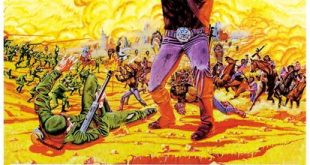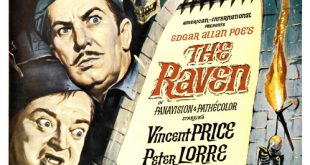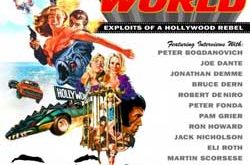 SYNOPSIS:
SYNOPSIS:
“Jake Gittes is a private detective who seems to specialise in matrimonial cases. He is hired by Evelyn Mulwray when she suspects her husband Hollis, builder of the city’s water supply system, of having an affair. Gittes does what he does best and photographs him with a young girl but in the ensuing scandal, it seems he was hired by an impersonator and not the real Mrs. Mulwray. When Mr. Mulwray is found dead, Jake is plunged into a complex web of deceit involving murder, incest and municipal corruption all related to the city’s water supply.” (courtesy IMDB)
REVIEW:
Los Angeles 1937 is a city in drought. Private detective Jake Gittes (Jack Nicholson) runs a successful investigation agency. Cocky, tough and well-groomed, Gittes is reminiscent of Raymond Chandler’s Phillip Marlowe, the archetypal cynical detective. Like one of Chandler’s classic stories, Chinatown (1974) takes more than a few incredible detours when an open-and-shut case of infidelity evolves into a conspiratorial labyrinth of deceit.
 The celebrated and convoluted opening moves into fourth gear when the body of Water And Power department chief Hollis Mulwray (Darrell Zwerling) is washed up in a run-off canal, with Gittes hired by Evelyn Mulwray (Faye Dunaway) to investigate the strange events surrounding her husband’s death. These events will lead Gittes into some very dark corners of not only the city, but of the human heart. He soon realises that inside every house, every office, every piece of land that he walks onto is someone who is very territorial and doesn’t want him intruding. Furthermore, he seems to take great pleasure in annoying them with his presence, especially after his nose is slashed open and must wear a large bloodied bandage on his face.
The celebrated and convoluted opening moves into fourth gear when the body of Water And Power department chief Hollis Mulwray (Darrell Zwerling) is washed up in a run-off canal, with Gittes hired by Evelyn Mulwray (Faye Dunaway) to investigate the strange events surrounding her husband’s death. These events will lead Gittes into some very dark corners of not only the city, but of the human heart. He soon realises that inside every house, every office, every piece of land that he walks onto is someone who is very territorial and doesn’t want him intruding. Furthermore, he seems to take great pleasure in annoying them with his presence, especially after his nose is slashed open and must wear a large bloodied bandage on his face.
 As Robert Towne‘s superbly constructed screenplay steadily evolves under Roman Polanski‘s detailed depiction of the city as a dangerous place, the template of the detective genre, is soon used as a platform to delve into the corrupt foundations of the American metropolis. Similar to Robert Altman’s subversive McCabe And Mrs. Miller (1971), where the Western format was used to convey a dank revisionist study of corruption and capitalism, Polanski and Towne create a densely-layered genre movie with a fiercely political subtext configured in sublime spatial arrangements.
As Robert Towne‘s superbly constructed screenplay steadily evolves under Roman Polanski‘s detailed depiction of the city as a dangerous place, the template of the detective genre, is soon used as a platform to delve into the corrupt foundations of the American metropolis. Similar to Robert Altman’s subversive McCabe And Mrs. Miller (1971), where the Western format was used to convey a dank revisionist study of corruption and capitalism, Polanski and Towne create a densely-layered genre movie with a fiercely political subtext configured in sublime spatial arrangements.
 Contrary to the oblique shadows of Film Noir classics like Laura (1944), Out Of The Past (1947) and Kiss Me Deadly (1957), Polanski bathes the spacious architecture in warm hues conducive to the sun-drenched environment. In contrast to the Spanish villas, Californian bungalows and sunny exteriors is a probing six-inch camera lens nestled so close to the actor’s faces at times, that each location seems to be engulfed from the inside-out, as foreground players recoil from each of the Arriflex impositions like scrutinised bugs. With Polanski’s recurring obsession with the act of watching deployed in the reflections of car mirrors, binoculars, still camera lenses and bawdy photographs, the viewer’s experience of watching, comprehending and processing the multi-layered material becomes intertwined with Gittes very own navigation of events.
Contrary to the oblique shadows of Film Noir classics like Laura (1944), Out Of The Past (1947) and Kiss Me Deadly (1957), Polanski bathes the spacious architecture in warm hues conducive to the sun-drenched environment. In contrast to the Spanish villas, Californian bungalows and sunny exteriors is a probing six-inch camera lens nestled so close to the actor’s faces at times, that each location seems to be engulfed from the inside-out, as foreground players recoil from each of the Arriflex impositions like scrutinised bugs. With Polanski’s recurring obsession with the act of watching deployed in the reflections of car mirrors, binoculars, still camera lenses and bawdy photographs, the viewer’s experience of watching, comprehending and processing the multi-layered material becomes intertwined with Gittes very own navigation of events.
 The eyes often function as a motif for Polanski and, in Chinatown, they are rendered as instruments of knowledge that provide evidence of victimisation, brutality and contrition, in as much as omnipresent observer, it also furthers the implicit voyeurism associated with his profession. Another brilliantly realised aspect of Polanski’s work is the sporadic and inventive use of the time-jump. In Chinatown this technique is epitomised wonderfully during one of Gittes ingenious investigatory methods involving a wristwatch being placed under the car tyre of a suspect he’s been tailing. Cut to a close-up of the now-shattered watch with its hands fixed in time, combined with Nicholson’s off-screen incredulity: “Jesus, he was there all night!” and another mysterious layer is stripped away.
The eyes often function as a motif for Polanski and, in Chinatown, they are rendered as instruments of knowledge that provide evidence of victimisation, brutality and contrition, in as much as omnipresent observer, it also furthers the implicit voyeurism associated with his profession. Another brilliantly realised aspect of Polanski’s work is the sporadic and inventive use of the time-jump. In Chinatown this technique is epitomised wonderfully during one of Gittes ingenious investigatory methods involving a wristwatch being placed under the car tyre of a suspect he’s been tailing. Cut to a close-up of the now-shattered watch with its hands fixed in time, combined with Nicholson’s off-screen incredulity: “Jesus, he was there all night!” and another mysterious layer is stripped away.
 Par-for-the-course in pulp fiction and Film Noir is the symbolic title of the investigating hero, either digging or smashing away at the mystery, like Sam Spade or Mike Hammer. The mispronunciation of Gittes by John Huston as ‘Gits’ takes this tacit metaphor further, with ‘Gits’ becoming both an acknowledgment of the detective as a figure of desire and as someone who always ‘gits’ his man. The casting of Huston as Noah Cross also maintains dual significance: As the director of the seminal Noir film The Maltese Falcon (1941), Huston stands as a self-reflexive symbol for the dark Hollywood films that Chinatown embraces; Meanwhile Huston’s enquiry into if Gittes is sleeping with his onscreen daughter amusingly refers to the relationship Nicholson was having with Huston’s real-life daughter, Anjelica.
Par-for-the-course in pulp fiction and Film Noir is the symbolic title of the investigating hero, either digging or smashing away at the mystery, like Sam Spade or Mike Hammer. The mispronunciation of Gittes by John Huston as ‘Gits’ takes this tacit metaphor further, with ‘Gits’ becoming both an acknowledgment of the detective as a figure of desire and as someone who always ‘gits’ his man. The casting of Huston as Noah Cross also maintains dual significance: As the director of the seminal Noir film The Maltese Falcon (1941), Huston stands as a self-reflexive symbol for the dark Hollywood films that Chinatown embraces; Meanwhile Huston’s enquiry into if Gittes is sleeping with his onscreen daughter amusingly refers to the relationship Nicholson was having with Huston’s real-life daughter, Anjelica.
 Chinatown succeeds on a number of levels, with a myriad of exciting narrative turns eventually culminating in a street scene of sobering stillness. With the hero forced to watch the climax from the sidelines, Polanski’s fatalist view of human endeavour is chillingly reinforced by the elongated sound of a solitary car horn echoing in the night. Yet, as Polanski’s bleak vision of the world is perfectly suited to the deserted Los Angeles landscape (depicted superbly in the warm hues of John Alonzo‘s photography), it’s his sensibility to combine human wickedness with scorching dialogue delivered with laconic charm by Nicholson that encapsulates a jaded world of corrupted innocence, disease and deceit. What’s remarkable is that this seedy detective is actually the most moral, principled man in this world. He quit walking the police beat in Chinatown because the cops there were supposed to let crime and corruption exist unhampered. As a private eye a few years later, he now sees this corruption has spread into Los Angeles proper, and is about to move unhindered into the ‘pure’ country.
Chinatown succeeds on a number of levels, with a myriad of exciting narrative turns eventually culminating in a street scene of sobering stillness. With the hero forced to watch the climax from the sidelines, Polanski’s fatalist view of human endeavour is chillingly reinforced by the elongated sound of a solitary car horn echoing in the night. Yet, as Polanski’s bleak vision of the world is perfectly suited to the deserted Los Angeles landscape (depicted superbly in the warm hues of John Alonzo‘s photography), it’s his sensibility to combine human wickedness with scorching dialogue delivered with laconic charm by Nicholson that encapsulates a jaded world of corrupted innocence, disease and deceit. What’s remarkable is that this seedy detective is actually the most moral, principled man in this world. He quit walking the police beat in Chinatown because the cops there were supposed to let crime and corruption exist unhampered. As a private eye a few years later, he now sees this corruption has spread into Los Angeles proper, and is about to move unhindered into the ‘pure’ country.
 While sick morticians splutter into their handkerchiefs over corpses and subnormal yokel farmers limp around on crutches, the strangest conceit Polanski embraces is the disfiguration of his attractive hero. In a strangely malicious scene, the director proves he can create an equally disturbing mood as an actor, taunting Nicholson at knife-point like a schoolyard punk: “You know what happens to nosy fellows? No? Wanna guess?” The brutal outcome of this chilling scene is a provocative visual that opposes the narcissistic demands of the studio-maintained star system. Yet, as Nicholson finds his face covered with bandages for the second half of the movie, Polanski bucks the system in this enduring masterpiece with an image converse to Hollywood star stereotypes, generic resolutions and Towne’s original ending.
While sick morticians splutter into their handkerchiefs over corpses and subnormal yokel farmers limp around on crutches, the strangest conceit Polanski embraces is the disfiguration of his attractive hero. In a strangely malicious scene, the director proves he can create an equally disturbing mood as an actor, taunting Nicholson at knife-point like a schoolyard punk: “You know what happens to nosy fellows? No? Wanna guess?” The brutal outcome of this chilling scene is a provocative visual that opposes the narcissistic demands of the studio-maintained star system. Yet, as Nicholson finds his face covered with bandages for the second half of the movie, Polanski bucks the system in this enduring masterpiece with an image converse to Hollywood star stereotypes, generic resolutions and Towne’s original ending.
 Perhaps the most concise summation of Polanski’s approach to film-making can be found earlier on in Chinatown, when the uncompromising hero pins down a doubting Dunaway. Equally comfortable in the unfamiliar and upper-class surroundings he now finds himself in, Gittes cuts straight through any crap to announce with cool authority: “I’m not in business to be liked – but I am in business.” And it’s with this thought in mind I’ll politely ask you to please join me next week when I will take you even closer to the event horizon of the insatiable black hole that is Hollywood for…Horror News! Toodles!
Perhaps the most concise summation of Polanski’s approach to film-making can be found earlier on in Chinatown, when the uncompromising hero pins down a doubting Dunaway. Equally comfortable in the unfamiliar and upper-class surroundings he now finds himself in, Gittes cuts straight through any crap to announce with cool authority: “I’m not in business to be liked – but I am in business.” And it’s with this thought in mind I’ll politely ask you to please join me next week when I will take you even closer to the event horizon of the insatiable black hole that is Hollywood for…Horror News! Toodles!
 Horror News | HNN Official Site | Horror Movies,Trailers, Reviews
Horror News | HNN Official Site | Horror Movies,Trailers, Reviews






